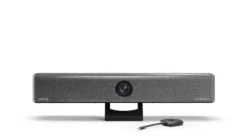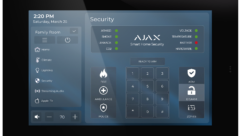Wireless technology and security systems: Technology and miniaturizationallow wireless systems to function as reliably as wired systems without allthat drilling, snaking, pulling and connecting.
Aug 1, 1997 12:00 PM,
Howard E. Friedman
The basics and principles of hardwired security systems were recentlydiscussed in both the February and April issues of S&VC. This month, as wecontinue this series, the spotlight is given to wireless technology. Inthis installment, we’ll become acquainted with its theory of operation, theproducts used in its implementation and how it has become one of thefastest-growing segments in the security industry.
Although hardwired systems do their job nicely, the need to unobtrusivelyinstall security systems has never been more necessary in residentialconstruction, where appearance has a significant effect on customersatisfaction. In many of today’s larger homes, building design makes itnearly impossible to run concealed wiring without drilling into molding,wallpaper or expensive paneling.
The popular solution, made possible by high technology and miniaturization,is wireless systems, which now enjoy wide acceptance in residentialsettings. Wireless systems show noticeable growth in the commercial market.
We all know that running wire can be difficult and time-consuming. Snaking,pulling and connecting it often involves a great deal of work andfrustration. Furthermore, keeping an inventory of the many wire types andsizes can be costly.
It’s no wonder that some security equipment manufacturers and installationcompanies have become quite successful in developing and marketing wirelesscomponents as their primary mission. Such systems offer the reliability ofwired systems yet are far faster and easier to install. Today’s bestwireless systems are advanced, feature-rich, durable and dependable, oftenequaling the capabilities of the finest hardwired installations.
A short historyElectronic garage door openers were among the first mass-produced wirelesssystems for consumers. They were initially unsophisticated, and becausethey were required to share the same frequency band, it was possible forone manufacturer’s handheld transmitter to inadvertently trigger anothermanufacturer’s receiver if installed close by. By the same token, thetransmitters used in early wireless security systems might sometimes causean alarm in a similar security installation in a nearby residence. Thesesame systems were prone to “false alarms” from large amounts of EMI(electro-magnetic interference), such as that accompanying a lightningdischarge, or concentrations of RFI (radio frequency interference), from apassing mobile radio. Many of the products were continuous wave (CW)systems, relying on the transmission and interruption of a continuouselectromagnetic radio wave, in much the same way as a telegraph or achild’s radio-driven toy truck would operate. (See Figure 1.)
Wireless add-ons
To learn how wireless technology is used in security systems, it’s best tostart with some basic add-on components before getting into completewireless systems. Subsystems, such as those consisting of wirelesstransmitters used for panic and medical emergencies, along with thestand-alone receiver module designed to process their transmissions, aremost often incorporated into hardwired systems, and their flexibilityprovides such customers with additional security via an untethered means ofsignaling panic and medical alarms. The necessary transmitters, powered bya small battery, could be worn or carried around the premises and could bequickly activated by the simple depression of a button. Its resultingsignal, when picked up by the wireless receiver, would trip an internalrelay, whose contacts, if wired to the desired hardwired zone in thecontrol panel, could cause the designated alarm to occur.
A variation of this concept can be found in the form of self-containedmedical and panicsystems, with the sole purpose of furnishing suchprotection, which are common entities in retirement communities all overthe country. Once a signal is received by the console, it is usuallyconveyed by digital communication techniques (see the earlier articles inthis series) to a monitoring facility, where the proper action can betaken. By definition, such systems are not equipped to provide any fire orintrusion protection.
Little by little, wireless add-ons to hardwired systems became quitecommon, and by the end of the 1970s they were employed in many residentialalarm installations and even in some small commercial jobs. Four- and eveneight-channel receivers soon appeared and could not only address the needfor portable medical and panic security but, through the additionalchannels, could provide support for intrusion and fire protection. Suppose,for example, that you wanted to protect a detached garage. Runningconcealed wiring between the garage and the house would probably be bothimpractical and expensive. Why not do it through wireless means – via theuse of a standard magnetic contact connected to a stationary transmitter,whose signal could be picked up by a receiver inside the premisesIn fact,in the same manner, the garage could also be provided with abattery-operated transmitting smoke detector whose transmissions could beused to trigger a fire alarm. (See Figure 2.)
Because these wireless add-ons were comparatively new back then, theytended to raise concerns in the minds of many alarm dealers and installers.
Modulation
The simple continuous wave principle could not hope to support the demandsof the security industry. In the years following Morse’s telegraph,inventors, such as Guglielmo Marconi, experimented with techniques toimpose audio frequencies upon the much higher frequencies needed to radiatethrough the air. Through his efforts and the efforts of many others, atechnique known as modulation was developed, making it possible to add”intelligence” to a transmitted radio wave. In this process, ahigh-frequency carrier wave could be mixed with any information (sound,speech, music, video, data) desired and transmitted to a remote receiver.(See Figure 3.)
Once the signal is received, a demodulator strips away the carrierfrequency, thus isolating the intelligent signal for further use. (SeeFigure 4.)
Bits of information
Then and now, AM and FM techniques have been used with analog signals: thetype found in both radio and television, shortwave and many forms of mobilecommunications. Recently it has been necessary to transmit data (words,numbers, punctuation, symbols and coded commands) in digital form. Suchdata is employed in many, many applications, from relaying simple signalsto pocket pagers or making subtle adjustments to the trajectories ofspacecraft. The transmitters used in wireless security systems transmitdigital data as well, and to find how and out why, it will help if we lookat some questions about wireless transmission:
How can we be sure that each transmission will not affect a nearbyelectronic garage door mechanism or another wireless security system?
The FCC, with the authority to regulate all communication systems withinour borders, has allocated designated frequency bands for use by wirelesssecurity systems. For the most part, they fall between 300 MHz and 350 MHz,but there are other allocations at approximately 40 MHz and between 900 MHzand 1 GHz. Even within these boundaries, the potential for unwantedinteractions between nearby systems is always there. However, it can beavoided through the use of a house code, which makes each installationpractically unique, even when located among identical neighboring systems.A single house code is given to the receiver and to each transmitter in theinstallation via a set of DIP (dual inline pin) switches. The positions inwhich the switches are placed would correspond to a pattern of binarydigits (“0s” and “1s,” called bits) that the transmitter would use tomodulate all of its transmitted signals. As long as each transmitter’shouse code matched that of the receiver, its transmissions could beprocessed and, as a result, all the components of one system are, ineffect, isolated from any other. The more DIP switches that are providedfor this function, the greater the number of house codes that would beavailable, making it that much less likely that transmissions from onesystem, even if identical to another nearby, would be intercepted andprocessed.
How is it possible to identify the transmissions of each individualtransmitter in a system?
By using another group of DIP switches, we can set a zone or ID number intoevery transmitter used in an installation. Many older systems provide fiveDIP switches for this purpose, offering 32 different combinations – usuallyenough for all but the largest systems. Just as with the house code, theswitch settings identifying a transmitter also modulate the carrier wave.Now, with a total of 13 bits so far, we can identify a particular system(using eight bits), and up to 32 transmitters within that installation(five bits). Later in this article we’ll see how some modern wirelesssystems no longer use DIP switches, and how it’s possible to include many,many more transmitters in a given system, each with a distinct zone or IDnumber. (See Table 1.)
How is it possible to distinguish the transmissions from medical, panic,intrusion and fire detectors?
As you might expect, additional bits are used to designate the functionthat a transmitter serves in the system. In the wireless systems thus fardescribed, we know that a transmitter can be used for sending in a panicalarm, a medical emergency, an intrusion (burglar) alarm or a fire alarm.If two more DIP switches were designated for this purpose, there would befour possible combinations. (See Figure 5.)
If a transmitter is used for intrusion, how do we know, before arming thesystem, that the point of entry it’s protecting is secure?
We have already defined the following 15 transmitted bits: eight bits givesthe house code, five bits identify the transmitter Zone or ID number, andtwo bits give the transmitter’s function code. Therefore, we can designateanother two bits, called the status bits, to indicate whether a contact (orloop of contacts) has been violated or restored. No DIP switches are neededfor the status information, since that is related to the action of thecontacts wired to the transmitter and generated internally. In Figure 6,when the window is opened, the transmitter sends its entire string ofinformation, including, in its status information, a report of theviolation. As soon as this signal is processed, the receiver’s “intrusion”relay will trip, affecting the zone in the hardwired system to which it’swired. If the alarm system is armed at the time, an alarm will result;otherwise, only the zone’s status will change. When the door closes, thetransmitter’s status information is updated and a new transmission takesplace, reflecting the restoration of the door contact. This serves to resetthe relay and restore the hardwired zone. Note that the relays in thereceiver are completely independent of the alarm control panel and theyenergize and de-energize only in response to the transmissions processed bythe receiver. For this reason, it’s easy to see that through such relayaction, the panel “knows” whether a contact is open or closed, and will actaccordingly at the time the system is armed.
How do we know that each transmitter is in place and hasn’t been removedHowdo we know that each will work when it’s supposed to?
You may remember our discussion of supervision in the two previous articleson hardwired systems. In such installations, it’s possible to check thesecurity of critical wiring by monitoring the small, continuous flow ofelectric current intentionally used to supervise it. With wireless, no suchmeans are available, but we can do the next best thing. In “supervised”wireless systems, each transmitter is expected to generate a signal atreasonable intervals-perhaps every hour or so, forthe benefit of thereceiving module.
So, when a transmitter is frequently triggered, as it might be if connectedto a front door contact, its supervision requirements might be easily met,and nothing further would be necessary. However, at night, when the door islikely to be unused, this transmitter would have to self-generate asupervisory signal at timely intervals. The same would be true of smokedetectors and many panic transmitters whose infrequent use would also makethis necessary. A supervisory transmission produces the same stream of bitswe’ve already covered but uses a special combination of status bits toidentify itself as a supervisory signal.
In a supervised arrangement like this, the receiving module keeps track ofeach transmitter’s activity by compiling an electronic “table.” Although itmay hear from each transmitter at least once an hour (and even morefrequently), it will check this table at regular intervals, known assupervision intervals, which may be programmable and range from every fourhours to every 24 hours, depending on the manufacturer. At the time of eachsupervision interval, it’s expected that each transmitter would have”checked in” at least once, with either a supervisory signal or a regulartransmission, although many signals could have been received from any giventransmitter during this interval. Had a transmitter failed to check-in atall, it will be the cause of a supervision failure (also known as a nocheck-in) and its zone or ID number will appear on the receiver’s LEDdisplay, accompanied by the illumination of a “trouble” LED. A supervisoryrelay in the receiver, apart from those used for alarm signals, can beapplied to the hardwired alarm control and alert both the customer and thecentral station.
Newer wireless systems employ long-life lithium batteries that are expectedto last for more than five years.
How can we tell the condition of each transmitter’s battery?
As you might expect by now, another bit in the transmission stringindicates the status of the transmitter’s battery. Using a “0” for OK and a”1″ for weak, this information appears in every transmission, whether it’sa supervisory transmission or one activated by a violation or an alarm. Atthe time a weak battery is discovered, about 30 days of useful life areleft before the battery can no longer be expected to perform. It’s alwaysbest to replace a battery as soon as the low-battery signal is received,since the 30 day period is, at best, only an approximation and is dependentupon a transmitter’s subsequent activity.
Newer wireless systems employ long-life lithium batteries that are expectedto last for more than five years. Older systems use alkaline batteries withan expected life span in security applications of only about a year.Incidentally, some smoke detectors may use two batteries: one to operatethe detector itself and the other for the transmitter’s circuitry. (SeeFigure 7.)
Usually, correcting the situation will reset the receiver’s display and itsrelay, although it may have a reset switch for this purpose, along with theability to scroll through multiple conditions, both alarm and trouble,which may have been logged.
What gets transmittedWhat actually gets transmitted is a stream of data which includes all theinformation we discussed. Although there are many ways to convey such datawithout wires, one of the most common employs a technique known asfrequency shift keying (FSK). A string of “1s” and “0s” is “imposed” on thecarrier wave. The result looks a lot like FM, except that there are onlytwo frequencies involved – one representing the binary “1,” which isslightly higher than the carrier, and the other representing binary “0,”which is slightly lower. (See Figure 8.)
In our example, 17 bits were used to convey all the necessary information,although a few more bits would likely be required in a “real” transmission.Once the transmitter goes on-line, it produces multiple and repeated burstsof the entire stream of bits to insure that the receiver will be given anample opportunity to “hear” it well enough to decode it. Although it mayappear to be a lot of data, the entire process takes well under one second.(See Figure 9.)
In this installment, we used a stand-alone wireless receiver and severaltransmitters to acquaint ourselves with wireless theory and its operationas found in security systems. In the next installment, we’ll covertransmission range, transmission testing and the do’s and don’ts of aninstallation. We’ll also learn how a transmitters’ house code and functionDIP switches have been replaced by a new technology, and we’ll review thewide variety of integrated sensor-transmitters now being used. Finally,we’ll take a look at modular and hybrid wireless systems – those engineeredto include hardwired and wireless components – and dedicated systems, whichare solely devoted to wireless operation.










